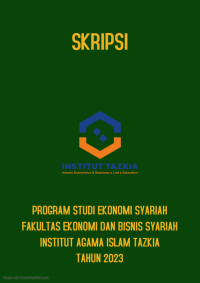Text
Analisis Perilaku Konsumen Muslim Terhadap Penggunaan Gopay Pasca Covid Di Jabodetabek
Goal: This study aims to determine the behavior of Muslim consumers in using the
e-wallet Gopay.
Method: This research uses a descriptive quantitative approach and enhance the
traditional Technology Acceptance Model (TAM) constructs with three additional
factors, namely perceived credibility, social influence and religiosity, to understand
customers behavioral intentions to adopt e-wallet Gopay. Data was collected from
the Jabodetabek Muslim community who use the e-wallet Gopay. Considering the
objectives and hypotheses, Partial Least Square Structural Equation Modeling
(PLS -SEM) technique was used to test the proposed model.
Fact/Finding: The tested model shows important observations, which clearly
outline that there is a significant relationship, which can be observed in this study.
there is a significant relationship, which can be observed here. It explicitly states:
perceived ease of use (PEOU) and perceived usefulness (PU) do not have a
significant positive relationship with behavioral intention of use (BIU), on the other
hand perceived credibility (PC), religiosity (RG) and also social influence (SI) have
a significant positive relationship with behavioral intention of use (BIU) which also
as the variables under study establish a significant positive relationship with actual
use (AU).
Availability
Detail Information
- Series Title
-
Ekonomi Syariah
- Call Number
-
REF 658.8342 MUB a
- Publisher
- Bogor : IAI Tazkia., 2023
- Collation
-
-
- Language
-
Indonesia
- ISBN/ISSN
-
NIM.19103024
- Classification
-
658.8342
- Content Type
-
-
- Media Type
-
-
- Carrier Type
-
-
- Edition
-
-
- Subject(s)
- Specific Detail Info
-
-
- Statement of Responsibility
-
Muhammad Althaf Mubarak
Other version/related
No other version available
File Attachment
Comments
You must be logged in to post a comment

 Computer Science, Information & General Works
Computer Science, Information & General Works  Philosophy & Psychology
Philosophy & Psychology  Religion
Religion  Social Sciences
Social Sciences  Language
Language  Pure Science
Pure Science  Applied Sciences
Applied Sciences  Art & Recreation
Art & Recreation  Literature
Literature  History & Geography
History & Geography